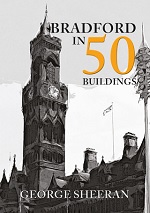Little Germany, Bradford – A Short History

By George Sheeran
The growth of textile warehouses in nineteenth-century Bradford is remarkable. This can be partly explained by a change to the way in which textile goods were marketed. No longer was yarn put out to spin at the behest of a master manufacturer or pieces of cloth ‘exposed for sale’ at a cloth hall, but both large and smaller manufacturers might deal directly with merchants on their own premises.
A further important development was the establishment of large merchant houses, often export houses that began to build company warehouses in the city. Bradford’s textile warehouses were built mostly after 1850 and located between the two rail heads of Exchange station and Forster Square station and contiguous areas.
They were of two types: home, dealing with the UK market, and shipping, dealing with exports. There was a particularly strong market with Germany for yarns and other textile goods, and several German shipping houses set up their businesses in an area leading from Forster Square past the (then) parish church and towards Leeds Road.
“Portico”
It appears to have been given the names ‘Germania’ or ‘New Germany’, while, according to John Roberts (Little Germany, 1977), ‘Little Germany’ appears to have come into common use after the 1870s, although the first references seem to have appeared in the Bradford Observer in the 1860s.
Little Germany is set on a sloping, awkward sort of site that soon became crowded with textile warehouses, often built on wedge-shaped pieces of land. This led the architects of some buildings to place principal entrances at the apex of the wedge, with goods entrances around the corner on a long side.
This can be seen in the Law Russell warehouse in the foreground (Lockwood & Mawson, 1874), where the portico is supported on crisply carved Corinthian columns of superb quality. This entrance rises through a further six storeys incorporating another four porticos – one above the other, diminishing in scale.
“Sculpted eagle”
In the background is the warehouse designed for Thornton, Homan & Co. (Lockwood & Mawson, 1871) with its carefully graded registers of windows and looking like an Italian Renaissance palace.
Not all businesses in Little Germany, however, traded with Germany. Thornton, Homan & Co. were a shipping house dealing with China and North America, the latter country symbolically represented by star-and-stripe motifs in the medallions above the first-floor window heads and the vigorously sculpted eagle above the entrance.
Within this district of the city characterised by its narrow streets and tall buildings are some of the finest textile warehouses in the UK.

 Extract taken from ‘Bradford in 50 Buildings’ by George Sheeran, published by Amberley Publishing, £14.99,
Extract taken from ‘Bradford in 50 Buildings’ by George Sheeran, published by Amberley Publishing, £14.99,
ISBN 9781445668482











